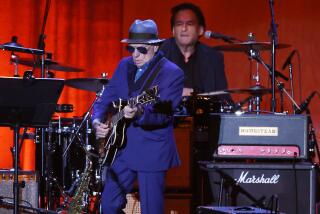A blast of a celebration
- Share via
The L.A. Phil couldn’t have picked a better way to start the jazz new year than with a tribute to pianist-composer Horace Silver. And, thankfully, it was a tribute that took place while the honoree was present to enjoy the accolades. Seated at the front of Walt Disney Concert Hall on Wednesday night, waving to a congratulatory crowd, the 78-year-old jazz veteran was presented with a virtual banquet of his works, performed by an all-star lineup of his former musical associates.
There was a lot of music from which to choose. In his more than 50 years of high visibility, Silver created an extraordinary body of work -- highly regarded when much of it was recorded in the ‘60s and subsequently covered by artists (both jazz and pop) of every jazz style and manner.
For this presentation, however, bassist Christian McBride, the L.A. Phil’s Creative Chair for Jazz, elected to showcase the music with players who either had performed or recorded with Silver or who were closely related, generationally or stylistically. McBride, with pianist Cedar Walton and drummer Roger Humphries, provided the basic rhythm section. They were joined by a sequence of trumpet-tenor saxophone pairings, reproducing the gutsy sound of the original Silver bands.
Trumpeter Tom Harrell and saxophonist Joe Lovano were the first duo to link up with the rhythm team. They kicked off the evening with a set featuring a pair of Silver classics: “Senor Blues” and “Nica’s Dream.” Harrell’s lyrical sound contrasted perfectly with Lovano’s dark-toned, urban tenor ruminations. And the basic elements of the Silver style were on full display: riff-driven accompaniment figures, often played in unison by piano and bass; spirited, immediately memorable melodies; a driving sense of swing, often enhanced by an undercurrent of Caribbean rhythm.
They were followed by trumpeter Charles Tolliver and tenor saxophonist Bennie Maupin in an especially engaging romp through “Psychedelic Sally.” Although the ensemble playing was propelled by characteristic Silver qualities, the horn soloing took a different slant through Tolliver’s slippery lines and Maupin’s outer limits improvising. When they were joined by singer Andy Bey, applying his utterly original style to “Peace Is for Everyone,” yet another aspect of Silver’s music surfaced: the fascination with matters of mind and spirit that began to become integral to his art in the early ‘70s.
The final duo, trumpeter Randy Brecker and saxophonist George Coleman, produced the most authentic-sounding simulation of the early Silver groups in “That Healin’ Feelin’ ” and “Gregory Is Here.” Coleman’s hard-bop tenor united with Brecker’s clarion sound and well-crafted soloing in a jaunty revival of the irresistibly foot-tapping, body-moving qualities of Silver’s ‘60s bands.
Keeping the mood alive, Dee Dee Bridgewater brought her charismatic ebullience to a pair of high-spirited Silver classics, “Doodlin’ ” and “Filthy McNasty,” followed by a climactic all-join-in version of Silver’s best-known composition, “Song for My Father,” performed by the full complement of players.
It was an appropriate musical conclusion to an embracing evening -- a worthy celebration of a musical life that matters.
More to Read
The biggest entertainment stories
Get our big stories about Hollywood, film, television, music, arts, culture and more right in your inbox as soon as they publish.
You may occasionally receive promotional content from the Los Angeles Times.










